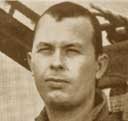We kick off our new Survival Series as a tribute to the countless veterans and civilians who have pulled through just horrible situations due to good training, confidence, and clear thinking under pressure.
Panic is always a death sentence in these situations, and a little luck appreciated, although there usually is no time to pray for it.
The day was June 21rst, 1963. Marine 1rst Lt. Cliff Judkins found himself in a tanker refueling disaster which turned his F-8 Crusader into a Roman Candle. Miracle number one was his plane did not blow up at the beginning of the story or it would be over now.
Both attempts at the usual seat ejection were failures. So now the ante had been raised on Lt. Judkins. He had to do something no one had ever done before…manually bail out of a Crusader and 220 knots and not be killed instantly in the process. The tail section of a Crusader is twenty feet high, a big target. Miracle number two was that he actually pulled this off by ‘skidding’ the plane before he jumped.
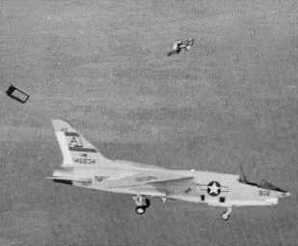
But the bad luck demons where not finished with this pilot yet. They raised the ante once again. When he pulled his ripcord he had what skydivers call a ‘streamer’…the chute deploys but with the lines wrapped around it so it will not open.
This only slows your descent speed down a little bit, maybe 10%.
There was no miracle on the way down. Lt. Judkins did everything he could to try to untangle his chute chute lines but the air pressure from the fast descent kept the it closed.
Amazingly when he brokethrough the clouds he glimpsed his plane hitting the water. At this point, you kind of start thinking you are a dead man.
Miracle number three appeared. Incredibly he was not killed on impact, nor did he drown while being unconscious. But the demons were not done with him yet.
His chute finally opened under the water but filling up with the ocean currents which were pulling him under. Because of his injuries (broken back, both ankles, pelvis, collapsed lung, plus kidneys and intestines in shock) he could not reach his leg knife, but he had a back up knife in his chest pocket which he used to cut free from his chute lines before they dragged him under…miracle number four.
But alas, the demons were still not done. They had one more shot. The first two life rafts dropped by the refueling tanker where not close enough for him to grab. An hour later a Coast Guard amphibian plane arrived but the heavy swells were too big for a water landing.
The pilot skillfully dropped another raft, but this time with a 200 foot line on it which Lt. Judkins was able grab and pull the raft in to him. That was miracle number five.
I will turn the story over to Cliff Judkins now for his first person delivery. As you read through the rest of this incredible story take a moment to think of all the other pilots who went through similar unfortunates mishaps but did not make it. This is as close as you and I will get to having any idea what it was like.
And if you would to see the faces of some of those who did not, I found a link for you here for all the F-8 Crusaders ejection crashes, where I found Lt. Judkins photo.
UPDATE: May 19, 2001. Cliff came by this morning for a video interview at my home studio. I will be adding the highlights to this article, but probably not until after Memorial Day, a major deal here in Atlanta. See some of my last year’s highlights from our historic Marietta Cemetary with General Honore as our main speaker. Scroll down the home page and be sure to click the 480p resolution for some great veterans video. Jim W. Dean, Heritage TV…Atlanta
”Jud you’re on fire, get the hell out of there!” Needless to say that startling command got my attention. As you will read in this report, this was just the beginning of my problems!
After a moment of jockeying for position, I made the connection and matched my speed to that of the slowpoke tanker. I made the graceful task of plugging into the trailing fuel conduit so they could pump fuel into my tanks.
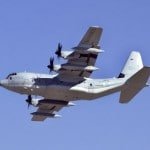
This in-flight refueling process was necessary, and routine, because the F-8 could not hold enough fuel to fly from California to Hawaii. This routine mission was labeled “Trans-Pac,” meaning Flying Airplanes across the Pacific. This had been going on for years.
Soon, after plugging-in to the tanker, my fuel gauges stirred, showing that all was well. In my cockpit, I was relaxed and confident.
As I was looking around, I was struck for an instant by the eeriness of the scene: here I was, attached, like an unwanted child, by an umbilicus to a gargantuan mother who was fleeing across the sky at 200 knots as though from some unnamed danger.
Far below us was a broken layer of clouds that filtered the sun glare over the Pacific.
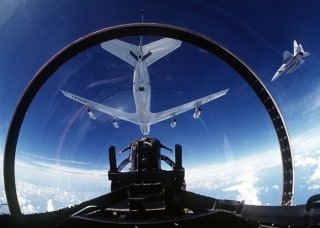
In my earphones, I heard Major Van Campen, our flight leader, chatting with Major D.K. Tooker who was on a Navy destroyer down below.
Major Tooker had ejected from his aircraft, the day before, in this same area, when his Crusader flamed out mysteriously during the same type of refueling exercise.
At that time no one knew why his aircraft had flamed out. We all supposed it had been some freak accident that sometimes happens with no explanation. One thing we knew for sure, it was not pilot error.
This accident had to be some kind of mechanical malfunction, but what? Our squadron had a perfect safety record and was very disturbed because of the loss of an airplane the day before. Eleven minutes to mandatory disconnect point, the tanker commander said. I checked my fuel gages again, everything appeared normal.
My thoughts were, In a few hours I knew we’d all be having dinner at the Kaneohe Officers Club on Oahu, Hawaii. Then after a short rest, we’d continue our 6,000-mile trek to Atsugi, Japan, via Midway and Wake Island. Our whole outfit – Marine All Weather Fighter Squadron 323 – was being transferred to the Far East for a one-year period of operations.
Nine minutes to mandatory disconnect. My fuel gages indicated that the tanks were almost full. I noticed that my throttle lever was sticking a little. That was unusual, because the friction lock was holding it in place and was loose enough. It grew tighter as I tried to manipulate it gently.
Then – thud! I heard the crack of an explosion.
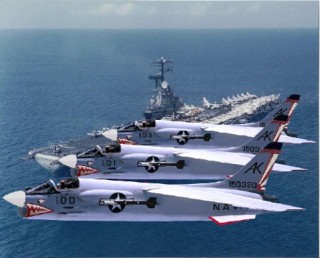
I could see the rpm gauge unwinding and the tailpipe temperature dropping. The aircraft had lost power the engine had quit running this is a flame-out!
I punched the mike button, and said, This is Jud. I’ve got a flame-out. Unfortunately, my radio was already dead; I was neither sending nor receiving anything via my radio.
I quickly disconnected from the tanker and nosed the aircraft over, into a shallow dive, to pick up some flying speed to help re-start the engine. I needed a few seconds to think.
I yanked the handle that extended the air-driven emergency generator, called the Ram Air Turbine (RAT), into the slipstream, hoping to get ignition for an air start.
The igniters clicked gamely, and the rpm indicator started to climb slowly, as did the tailpipe temperature. This was a positive indication that a re-start was beginning. For one tantalizing moment I thought everything would be all right. But the rpm indicator hung uncertainly at 30 percent of capacity and refused to go any faster. This is not nearly enough power to maintain flight.
The fire warning light (pilots call it the panic light) blinked on. This is not a good sign. And to make matters worse, jet fuel poured over the canopy like water from a bucket. At the same instant, my radio came back on, powered by the emergency generator, and a great babble of voices burst through my earphones. Jud, you are on fire, get out of there!
Fuel was pouring out of my aircraft; from the tailpipe; from the intake duct; from under the wings, and igniting behind me in a great awesome trail of fire.
The suddenness of the disaster overwhelmed me, and I thought: This can’t be happening to me! The voices in my ears kept urging me to fire the ejection seat and abandon my aircraft. I pressed my mike button and told the flight leader, I’m getting out!
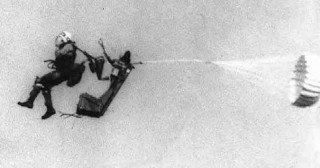
I took my hands off the flight controls and reached above my head for the canvas curtain that would start the ejection sequence. I pulled it down hard over my face and waited for the tremendous kick in the pants, which would send me rocketing upward, free of the aircraft.
Nothing happened! The canopy, which was designed to jettison in the first part of the ejection sequence did not move. It was still in place and so was I.
My surprise lasted only a second. Then I reached down between my knees for the alternate ejection-firing handle, and gave it a vigorous pull. Again, nothing happened. This was very surprising. Both, the primary, and the secondary ejection procedures had failed and I was trapped in the cockpit of the burning aircraft.
The plane was now in a steep 60-degree dive. For the first time, I felt panic softening the edges of my determination. I knew that I had to do something or I was going to die in this sick airplane. There was no way out of it. With great effort, I pulled my thoughts together and tried to imagine some solution.
A voice in my earphones was shouting: Ditch the plane! Ditch it in the ocean! It must have come from the tanker skipper or one of the destroyer commanders down below, because every jet pilot knows you can’t ditch a jet and survive. The plane would hit the water at a very high a speed, flip over and sink like a stone and they usually explode on impact.
I grabbed the control stick and leveled the aircraft. Then I yanked the alternate handle again in an attempt to fire the canopy and start the ejection sequence, but still nothing happened. That left me with only one imaginable way out, which was to jettison the canopy manually and try to jump from the aircraft without aid of the ejection seat.
Was such a thing possible? I was not aware of any Crusader pilot who had ever used this World War II tactic to get out of a fast flying jet. I had been told that this procedure, of bailing out of a jet, was almost impossible.
Yes, the pilot may get out of the airplane but the massive 20-foot high tail section is almost certain to strike the pilot’s body and kill him before he falls free of the aircraft. My desperation was growing, and any scheme that offered a shred of success seemed better than riding that aircraft into the sea, which would surely be fatal.
I disconnected the canopy by hand, and with a great whoosh it disappeared from over my head never to be seen again. Before trying to get out of my confined quarters, I trimmed the aircraft to fly in a kind of sidelong skid: nose high and with the tail swung around slightly to the right.
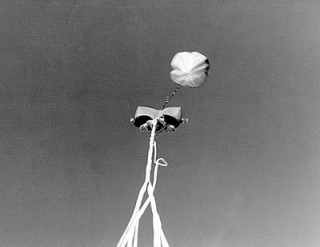
Then I stood up in the seat and put both arms in front of my face. I was sucked out harshly from the airplane.
I cringed as I tumbled outside the bird, expecting the tail to cut me in half, but thank goodness, that never happened! In an instant I knew I was out of there and uninjured.
I waited . . . and waited . . . until my body, hurtling through space, with the 225 knots of momentum started to decelerate. I pulled the D-ring on my parachute, which is the manual way to open the chute if the ejection seat does not work automatically.
I braced myself for the opening shock. I heard a loud pop above me, but I was still falling very fast. As I looked up I saw that the small pilot chute had deployed. (This small chute is designed to keep the pilot from tumbling until the main chute opens.)
But, I also noticed a sight that made me shiver with disbelief and horror! The main, 24-foot parachute was just flapping in the breeze and was tangled in its own shroud lines. It hadn’t opened! I could see the white folds neatly arranged, fluttering feebly in the air.
This is very serious, I thought. Frantically, I shook the risers in an attempt to balloon the chute and help it open. It didn’t work. I pulled the bundle down toward me and wrestled with the shroud lines, trying my best to get the chute to open. The parachute remained closed. All the while I am falling like a rock toward the ocean.
I looked down hurriedly. There was still plenty of altitude remaining. I quickly developed a frustrating and sickening feeling. I wanted everything to halt while I collected my thoughts, but my fall seemed to accelerate.
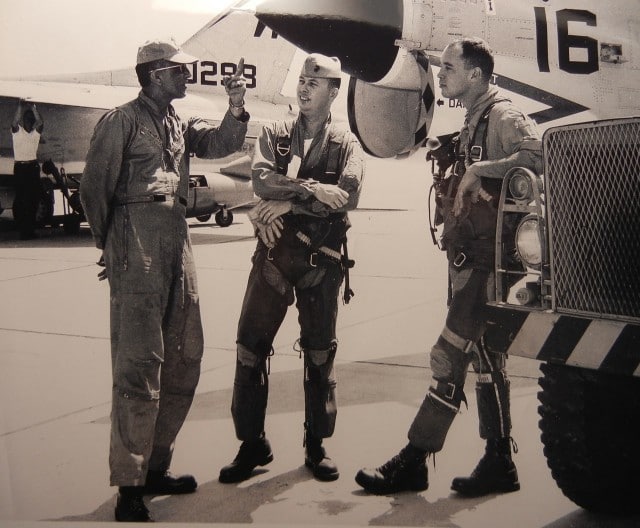
I noticed a ring of turbulence in the ocean. It looked like a big stone had been thrown in the water. It had white froth at its center; I finally realized this is where my plane had crashed in the ocean. Would I be next to crash? were my thoughts!
Again, I shook the parachute risers and shroud lines, but the rushing air was holding my chute tightly in a bundle. I began to realize that I had done all I could reasonably do to open the chute and it was not going to open. I was just along for a brutal ride that may kill or severely injure me.
I descended rapidly through the low clouds. Now there was only clear sky between me and the ocean. This may be my last view of the living. I have no recollection of positioning myself properly or even bracing for the impact. In fact, I don’t remember hitting the water at all. At one instant I was falling very fast toward the ocean. The next thing I remember is hearing a shrill, high-pitched whistle that hurt my ears.
Suddenly, I was very cold. In that eerie half-world of consciousness, I thought, Am I alive? I finally decided, and not all at once, Yes, I think I am . . . I am alive!
The water helped clear my senses. But as I bounced around in the water I began coughing and retching. The Mae West around my waist had inflated. I concluded that the shrill whistling sound that I had heard was the gas leaving the CO2 cylinders as it was filling the life vest.
A sense of urgency gripped me, as though there were some task I ought to be performing. Then it dawned on me what it was. The parachute was tugging at me from under the water. It had finally billowed out (much too late) like some Brobdingnagian Portuguese man-of-war. I tried reaching down for my hunting knife located in the knee pocket of my flight suit. I had to cut the shroud lines of the chute before it pulled me under for good.
This is when I first discovered that I was injured severely. The pain was excruciating. Was my back broken? I tried to arch it slightly and felt the pain again. I tried moving my feet, but that too was impossible. They were immobile, and I could feel the bones in them grating against each other.
There was no chance of getting that hunting knife, but I had another, smaller one in the upper torso of my flight suit. With difficulty, I extracted it and began slashing feebly at the spaghetti-like shroud line mess surrounding me.
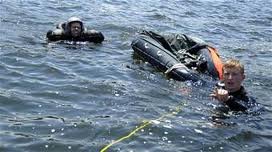
Once free of the parachute, I began a tentative search for the survival pack. It contained a one-man life raft, some canned water, food, fishing gear, and dye markers. The dye markers colored the water around the pilot to aid the rescue team in finding a down airman.
All of this survival equipment should have been strapped to my hips. It was not there. It had been ripped away from my body upon impact with the water.
How long would the Mae West sustain me I wondered. I wasn’t sure, but I knew I needed help fast. The salt water that I had swallowed felt like an enormous rock in the pit of my gut. But worst of all, here I was, completely alone, 600 miles from shore, lolling in the deep troughs and crests of the Pacific Ocean. And my Crusader aircraft, upon which had been lavished such affectionate attention, was sinking thousands of feet to the bottom of the ocean.
At that moment, I was struck by the incredible series of coincidences that had just befallen me. I knew that my misfortune had been a one-in-a-million occurrence. In review, I noted that the explosion aloft should not have happened.
The ejection mechanism should have worked. The parachute should have opened. None of these incidents should have happened. I had just experienced three major catastrophes in one flight. My squadron had a perfect safety record.Why was all of this happening was my thinking.
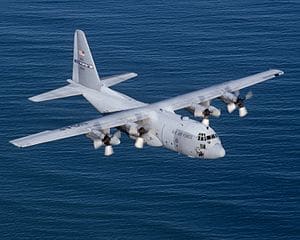
In about ten minutes I heard the drone of a propeller-driven plane. The pot-bellied, four-engine tanker came into view, flying very low. They dropped several green dye markers near me, and some smoke flares a short distance from my position. They circled overhead and dropped an inflated life raft about 50 yards from me.
I was so pleased and tried to swim toward the raft. When I took two strokes, I all most blacked out due to the intense pain in my body. The tanker circled again and dropped another raft closer to me, but there was no way for me to get to it, or in it, in my condition.
The water seemed to be getting colder, and a chill gripped me. I looked at my watch, but the so-called unbreakable crystal was shattered and the hands torn away.
I tried to relax and surrender to the Pacific Ocean swells. I could almost have enjoyed being buoyed up to the crest of one swell and gently sliding into the trough of the next, but I was in such excruciating pain. I remembered the words W.C. Fields had chosen for his epitaph: On the whole, I’d rather be in Philadelphia.
In about an hour, a Coast Guard amphibian plane flew over and circled me as though deciding whether or not to land. But the seas were high and I knew he couldn’t make it. He came in very low and dropped another raft; this one had a 200-foot lanyard attached to it.
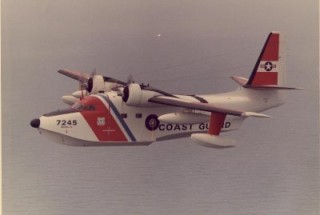
The end of the lanyard landed barely ten feet from me. I paddled gently backward using only my arms. I caught hold of it and pulled the raft to me.
Even before trying, I knew I couldn’t crawl into the raft due to my physical condition. I was able to get a good grip on its side and hold on. This gave me a little security.
The Coast Guard amphibian gained altitude and flew off. I learned later that he headed for a squadron of minesweepers that was returning to the United States from a tour of the Western Pacific.
He was unable to tune to their radio frequency for communications. But this ingenious pilot lowered a wire from his aircraft and dragged it across the bow of the minesweeper, the USS Embattle. The minesweeper captain understood the plea, and veered off at top speed in my direction.
I was fully conscious during the two and a half hours it took the ship to reach me. I spotted the minesweeper while teetering at the crest of a wave. Soon, its great bow was pushing in toward me and I could see sailors in orange life jackets crowding its lifelines. A bearded man in a black rubber suit jumped into the water and swam to me.
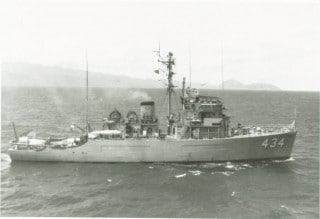
Are you hurt? he asked. Yes, I said. My legs and back. I was now very cold and worried about the growing numbness in my legs.
Perhaps the imminence of rescue made me light-headed, for I only vaguely remember being hoisted aboard the ship. I was laid out on the ship’s deck as they cut away my flight suit.
Don’t touch my legs! Don’t touch my legs, I screamed. I don’t remember it. Somebody gave me a shot of morphine and this erased part of my extreme pain.
An hour or so later a man was bending over me and asking questions. (It was a doctor who had been high-lined over from the USS Los Angeles, a cruiser that had been operating in the area.)
He said, You have a long scar on your abdomen. How did it get there? I told him about a serious auto accident I’d had four years earlier in Texas, and that my spleen had been removed at that time.
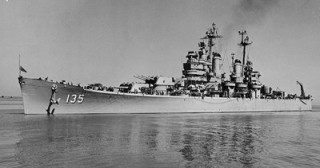
He grunted, and asked more questions while he continued examining me. Then he said, You and I are going to take a little trip over to the USS Los Angeles; it’s steaming alongside.
Somehow they got me into a wire stretcher, and hauled me, dangling and dipping, across the watery interval between the Embattle and the cruiser.
In the Los Angeles’s sickbay, they gave me another shot of morphine, thank God, and started thrusting all sorts of hoses into my body. I could tell from all the activity, and from the intense, hushed voices, that they were very worried about my condition.
My body temperature was down to 94 degrees; my intestines and kidneys were in shock. The doctors never left my side during the night. They took my blood pressure every 15 minutes. I was unable to sleep. Finally, I threw-up about a quart or more of seawater. After this my nausea was relieved a bit.
By listening to the medical team, who was working on me, I was able to piece together the nature of my injuries. This is what I heard them saying. My left ankle was broken in five places. My right ankle was broken in three places. A tendon in my left foot was cut. My right pelvis was fractured. My number 7 vertebra was fractured. My left lung had partially collapsed. There were many cuts and bruises all over my face and body, and, my intestines and kidneys had been shaken into complete inactivity.
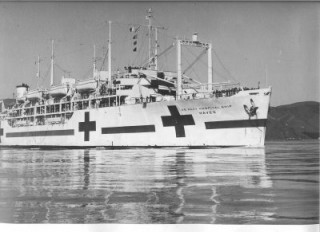
The next morning Dr. Valentine Rhodes told me that the Los Angeles was steaming at flank speed to a rendezvous with a helicopter 100 miles from Long Beach, California.
At 3:30 that afternoon, I was hoisted into the belly of a Marine helicopter from the USS Los Angeles’ fantail, and we whirred off to a hospital ship, the USS Haven, docked in Long Beach, CA.
Once aboard the Haven, doctors came at me from all sides with more needles, tubes, and X-ray machines. Their reaction to my condition was so much more optimistic than I had expected. I finally broke down and let go a few tears of relief, exhaustion, and thanks to all hands and God.
Within a few months I was all systems go again. My ankles were put back in place with the help of steel pins. The partially collapsed left lung re-inflated and my kidneys and intestines were working again without the need of prodding.
The Marine Corps discovered the cause of my flame-out, and that of Major Tooker, the day before, was the failure of an automatic cut-off switch in the refueling system. The aircraft’s main fuel tank was made of heavy reinforced rubber. When the cut-off switch failed, this allowed the tank to overfill and it burst like a balloon. This then caused the fire and flame out.
We will never know why the ejection seat failed to work since it is in the bottom of the ocean. The parachute failure is a mystery also. Like they say, “Some days you are the dog, and others you are the fire-plug.”
Do I feel lucky? That word doesn’t even begin to describe my feelings. To survive a 15,000-foot fall with an unopened chute is a fair enough feat. My mind keeps running back to something Dr. Rhodes told me in the sickbay of the Los Angeles during those grim and desperate hours.
He said that if I had had a spleen, it almost certainly would have ruptured when I hit the water, and I would have bled to death. Of the 25 pilots in our squadron, I am the only one without a spleen. It gives me something to think about. Maybe it does you as well.******
Well folks, that was a rare story…which is why it is up here. An extra treat for me was I was able to leave a phone message for Cliff Judkins this afternoon as he lives in Atlanta. We had a nice get to know you chat tonight, and learned that we both share not having a spleen, for the same reason….bad car wrecks at similar ages.

We are both WWII buffs, and it turns out he is in the Old Guard here in Atlanta, the oldest military organization we have, dating from the first Militia in 1857, and I have a batch of old heritage friend there, SCV people and Vets. Thank Al Gore, for inventing the Internet !!! 🙂
So the story full of bad and good flukes ended on a good one. We will be doing some video work and posting that later. Email me if you want to notified when it is ready….Jim Dean
You can peruse VT’s – Jim W. Dean archives right here !
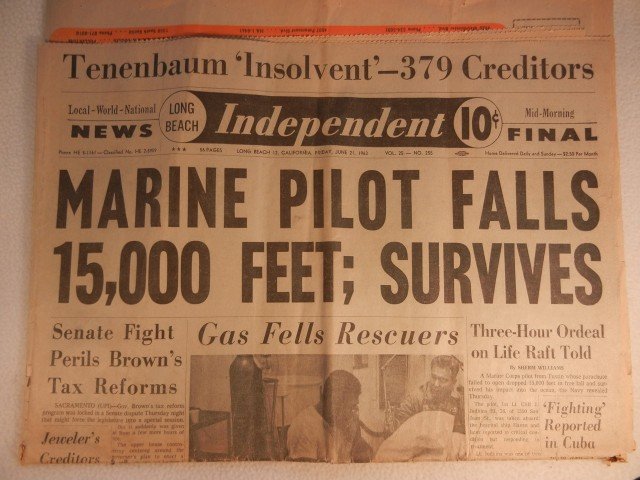

Jim W. Dean was an active editor on VT from 2010-2022. He was involved in operations, development, and writing, plus an active schedule of TV and radio interviews.
ATTENTION READERS
We See The World From All Sides and Want YOU To Be Fully InformedIn fact, intentional disinformation is a disgraceful scourge in media today. So to assuage any possible errant incorrect information posted herein, we strongly encourage you to seek corroboration from other non-VT sources before forming an educated opinion.
About VT - Policies & Disclosures - Comment Policy

![f8inflbw[1]](https://www.veteranstodayarchives.com/wp-content/uploads/2011/05/f8inflbw11.jpg)
